AEC Magazine talked with Marc Goldman, director AEC Industry Solutions at Esri about how the company is working with BIM developers to better integrate GIS for AEC professionals
AEC Magazine: Why should your average architect be interested in GIS?
Marc Goldman: In my short stint as a designer (I can’t call myself an architect or engineer because I don’t have licences nor ever did) I recall the challenge of putting my first line on paper or screen. Having geographic context allows you to overcome that inertia, provides you with greater understanding, brings insights to the surface, and allows designs and engineered projects to begin with the most amount of valuable information to be accessed, managed, and used for decision-making.
AEC: Revit is a key application for readers of AEC Magazine. On a technical level, how does ArcGIS work with Revit data – both in terms of geometry and attributes?
MG: In ArcGIS Pro we can import RVTs, store the geometry and attributes in a geodatabase that captures some of the semantics of the Revit file, and then use the geometry and attributes in GIS workflows, such as by converting them to I3S Building Scene Layers that can be streamed over the web to mobile and desktop experiences.
AEC: The first stage of the Autodesk / Esri partnership was about connecting Autodesk’s desktop applications to ArcGIS. But the real prize comes from cloud — connecting Esri ArcGIS and Autodesk BIM 360. What’s the latest on this and why is it so important to AEC firms?
MG: We’re working on a cloud-to-cloud integration which will allow GIS dashboards, maps and analysis to be performed using any files and data in BIM 360, and from other cloud environments. This ‘cloud to cloud’ communication, whereby the data in either cloud is accessible to users in browsers and mobile apps, opens to door to workflows we’ve only dreamed of in the AEC industry.

AEC: Esri previously told us that BIM / GIS integration isn’t just about giving BIM models a GIS context, it’s also about giving AEC firms access to Esri services. Can you explain more about these services and how AEC firms can benefit? And what are the challenges of big data?
MG: Let me first talk about civil BIM and then get onto the “building” BIM side. On the civil BIM side, within [AutoCAD] Civil 3D and Infraworks, engineers have access to the layers and data you’d use or manage in ArcGIS Pro, or which you’d visualise and interact in ArcGIS Online. One benefit is streamlining workflows, so as data is collected in the field with Esri field-based apps, that data appears in real time on the engineer’s desktop in Civil 3D or Infraworks.
As to improving quality, in Civil 3D and Infraworks you have access to the GIS data layers to better understand the project’s constraints. All this means individuals and teams can make informed design and engineering decisions by visualising collaboratively, the Infrastructure and GIS data directly.
Looking at Building BIM, once the BIM (RVT or IFC) has been imported to ArcGIS Pro, the information is managed like other geodatabase or shapefile data sources. This allows the BIM objects themselves to be understood visually – sliced and diced on screen.
Users can tap into the properties of the BIM objects and of the project itself, getting deeper understandings than any “viewer” and easier than any modelling app. Architects, engineers, contractors and owners collaborate with a common view into the intelligence which can be gleaned from the BIM.
The challenges of ‘Big Data’ for any AEC industry technology provider are the same as those of most any industry. How do we address the goal of transforming massive amounts of spatial data into manageable information? And what do we do with this ability and how do we deliver value from the data? The answer is, we’ve been doing this for decades and now we’re also ingesting real-time data from sensors, and IoT systems and delivering actionable information that automatically scales to the analysis and data storage needs of the facility or infrastructure project.

Through our solutions, users reveal spatial patterns that animate and automatically aggregate as real-time data streams. Using time as a variable you can visualise massive datasets in four dimensions and identify data patterns that were previously hidden in the noise of spreadsheets, revisions and endless logs. It’s also possible to find clusters and hot spots of activity. Using regression tools, we’re able to find relationships between datasets and predict future events which drive building control systems and other systems effecting performance and optimisations.
We know how to make sense of massive imagery collections. We’re experts in using distributed processing and deep learning for object detection, classification, terrain analysis, and change detection on any scale.
We don’t see many unique challenges; we see many opportunities in fact.
AEC: Last year Autodesk admitted that it needed to work closer with Esri and engage with AEC customers together, rather than as separate entities. Is that now happening and what have Autodesk and Esri learnt from this?
MG: We’re working very closely together. I have two or three calls weekly with Autodesk and I’m one of a several at Esri working with Autodesk. We’re hosting a series of Joint Customer Council meetings in the US and Europe, and we’re working on various tactical efforts and strategic initiatives with our shared customers.
Our technical teams work closely on the ArcGIS Connector for Civil 3D and the ArcGIS Connector for Infraworks, as well as Revit & ArcGIS interop and a number of code-named projects at various stages of exploration and development.
We’ve learned where our efforts are bringing value to users across a number of workflows and segments of AEC. Currently the greatest value, the most compelling integrations and user adoption is in Civil related projects. However, building projects are certainly benefitting as well from the earliest stages of planning through building operations. Esri and Autodesk are working together with our combined customers delivering new capabilities, higher productivity and better collaboration at the intersection of GIS and BIM.
AEC: What’s Esri’s strategy in the digital twin market, this mixes GIS, BIM, point cloud and all project data?
MG: Digital twin is one of those industry terms that means something different to everyone. But that’s OK – a digital twin can mean various things to different people. At this point in time, the term is not used always the same nor is a digital twin comprised of the same information from one project to another, one client to another, and one portfolio to another.
We don’t throw the term “digital twin” around as much as some others in this industry. If there’s ever been a platform suited to deliver the promise of a digital twin it’s the ArcGIS platform. The platform can be a critical component of, or even the hub of, a Connected Data Environment which collects, analyses and provides insight on a built project from the earliest stages of planning through to ongoing operations and maintenance. We connect to data repositories and document management systems as part of a digital twin strategy, and we connect to the data streams from beacons and IoT devices. We bring this together to deliver the capabilities which our industry is associating with the idea of a digital twin. We’re just not throwing that term around so widely.

AEC: How does ArcGIS work with IoT information and what instances have there been of customers implementing this in construction/building that you can talk about?
MG: We have a product called Analytics for IoT, which is fully integrated with ArcGIS. It enables users to ingest, visualise, and analyse spatial real-time and big data.
Without getting too specific, the US Dept of Energy is one of our customers; we’re working with several of the DoE laboratories exploring projects where the intersection of IoT meets energy modelling and proactive building performance management with 3D interaction and easy to use dashboards. We are still exploring.
AEC: Outside of Autodesk, which other application developers has Esri been working with? Nemetschek, Trimble, Bentley? And what level of integration can we expect? Any interesting cooperation projects going on? (Vectorworks is the leader in landscape software for instance)
MG: Nemtschek – yep! Their landscape leadership with Vectorworks is of great interest and we have a partnership with them announced back in November. Vectorworks has a built an integration to ArcGIS – we’re a logical starting point, reference point and deliver insights to Vectorworks users. And, it doesn’t hurt Esri’s founder and our president, Jack Dangermond, has a Master’s Degree in Landscape Architecture. To this day as the company grows, he is involved in the location and orientation every bit of landscaping at the most lush and welcoming campus I’ve ever visited, Esri’s in Redlands, CA.
Trimble – yep! We have worked collaboratively for years. The most successful collaboration has been between their Trimble Geospatial Solutions group and our Field Apps team. We have worked together to bring high accuracy GNSS solutions for Esri products (such as Collector).
AEC: What roles are AI and simulation playing in GIS and what kind of applications have we seen/can we expect to see in digital construction, civil and urban planning?
MG: The industry has a need to capture the condition, location and other statuses, and expect intervention through AI and ML – we’ve developed and delivered this in multiple cases.
We’ve applied recognition of visual assets through photo and video capture for civil engineering and urban planning. Specifically, classification of infrastructure assets along miles of urban and rural environments.
I envision we’ll see operations managers, project superintendents, and machine operators use AI to fill in the gaps in planning and scheduling databases, track materials assets in real time, accurately predict arrival times, installation, and anticipate future services and maintenance needs to stay one step ahead. There’s really nothing to keep us from delivering this today.
AEC: What are the product development key focus points for Esri in the building/construction space for the next couple of years?
MG: There are a number of key focus points: obviously, enabling digital project delivery for projects of all size.
We aim to deliver solutions that bring the field and the office closer together through the aggregation, curation and delivering insights through the combination of: reality capture data, BIM / VDC and schedules.
We will continue to bring the worlds of BIM and GIS together to realise the full potential of integrated workflows between what were once competing technologies.
Also, we want to replace paper-based workflows with digital solutions that aggregate information into insightful common and connected environments.
■ esri.com
If you enjoyed this article, subscribe to our email newsletter or print / PDF magazine for FREE







